I am trying to do 2 things:
First and most important is to somehow get the y axis to vary by the outcome_type2 variable, since they all have fairly different ranges. So the "C" have their own axis range, the "Z" have their own axis range, and the "SS" have their own axis range.
Then the secondary thing would be to somehow adjust the spacing of columns, so that there's a bit of space by those same groups--the 3 "C" columns would be close together, with a bit of extra white space between them and the "Z", then same between "Z" and "SS". Just to differentiate a little more between those three groups.
I tried tinkering with faceting on outcome_type2 instead of outcome_type but to no avail.
This is current base code, which technically works fine, but as you'll see, having them all use the same Y axis really swamps the "Z" and "SS" panels.
ggplot(dtest, aes(x = var2, y = avg2, fill = var2)) +
geom_bar(stat = "identity",
width = 1) +
facet_grid(wave ~ forcats::fct_relevel(outcome_type, "CT", "CI", "CE", "FZ", "MZ", "PSS", "CSS"),
scales = "free_y",
space = "free_y") +
theme_minimal() +
theme(legend.position = "none")
dtest <- structure(list(outcome_type = c("CT", "CT", "CT", "CI", "CI",
"CI", "CE", "CE", "CE", "FZ", "FZ", "MZ", "MZ", "PSS", "PSS",
"CSS", "CSS", "CT", "CT", "CT", "CI", "CI", "CI", "CE", "CE",
"CE", "FZ", "FZ", "MZ", "MZ", "PSS", "PSS", "CSS", "CSS"), wave = c("Wave 1",
"Wave 2", "Wave 3", "Wave 1", "Wave 2", "Wave 3", "Wave 1", "Wave 2",
"Wave 3", "Wave 2", "Wave 3", "Wave 2", "Wave 3", "Wave 1", "Wave 3",
"Wave 1", "Wave 3", "Wave 1", "Wave 2", "Wave 3", "Wave 1", "Wave 2",
"Wave 3", "Wave 1", "Wave 2", "Wave 3", "Wave 2", "Wave 3", "Wave 2",
"Wave 3", "Wave 1", "Wave 3", "Wave 1", "Wave 3"), var2 = c("Skipped",
"Skipped", "Skipped", "Skipped", "Skipped", "Skipped", "Skipped",
"Skipped", "Skipped", "Skipped", "Skipped", "Skipped", "Skipped",
"Skipped", "Skipped", "Skipped", "Skipped", "Attended", "Attended",
"Attended", "Attended", "Attended", "Attended", "Attended", "Attended",
"Attended", "Attended", "Attended", "Attended", "Attended", "Attended",
"Attended", "Attended", "Attended"), avg2 = c(30.21, 20.88, 25.43,
7.68, 8.26, 7.89, 11.15, 8, 5.99, 1.64, 0.43, 0.6, 0.77, 0.01,
-0.09, -0.2, -0.01, 24.01, 19.98, 29.04, 9.82, 12.41, 12.99,
14.35, 11.01, 10, 2.36, 2.3, 1.51, 0.91, -0.23, -0.35, -0.17,
-0.14), outcome_type2 = c("C", "C", "C", "C", "C", "C", "C",
"C", "C", "Z", "Z", "Z", "Z", "SS", "SS", "SS", "SS", "C", "C",
"C", "C", "C", "C", "C", "C", "C", "Z", "Z", "Z", "Z", "SS",
"SS", "SS", "SS")), class = c("spec_tbl_df", "tbl_df", "tbl",
"data.frame"), row.names = c(NA, -34L), spec = structure(list(
cols = list(outcome_type = structure(list(), class = c("collector_character",
"collector")), wave = structure(list(), class = c("collector_character",
"collector")), var2 = structure(list(), class = c("collector_character",
"collector")), avg2 = structure(list(), class = c("collector_double",
"collector")), outcome_type2 = structure(list(), class = c("collector_character",
"collector"))), default = structure(list(), class = c("collector_guess",
"collector")), skip = 1L), class = "col_spec"))


